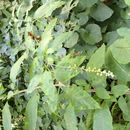pt-BR
nomes no trilho de navegação


The varieties are not always clearly distinct. Some specimens combine the erect inflorescences of var. rigida with the long pedicels of var. americana. Such intermediate plants can be seen as far north as coastal Delaware, sometimes growing with var. americana.
Collectors of Phytolacca americana should record carefully whether the inflorescences are erect, drooping, or intermediate between the extremes.
The fruits and seeds of Phytolacca americana are eaten and disseminated by birds and, probably, mammals. They are said to be an important source of food for mourning doves (A. C. Martin et al. 1951).
Phytolacca americana is well known to herbalists, cell biologists, and toxicologists. According to some accounts, its young leaves, after being boiled in two waters (the first being discarded) to deactivate toxins, are edible, even being available canned (they pose no culinary threat to spinach). Young shoots are eaten as a substitute for asparagus. Ripe berries were used to color wine and are eaten (cooked) in pies. Poke is used as an emetic, a purgative, a suppurative, a spring tonic, and a treatment for various skin maladies, especially hemorrhoids.
Pokeweed mitogen is a mixture of glycoprotein lectins that are powerful immune stimulants, promoting T- and B-lymphocyte proliferation and increased immun-oglobulin levels. "Accidental exposure to juices from Phytolacca americana via ingestion, breaks in the skin, and the conjunctiva has brought about hematological changes in numerous people, including researchers studying this species" (G. K. Rogers 1985). Poke antiviral proteins are of great interest for their broad, potent antiviral (including Human Immunodeficiency Virus) and antifungal properties (P. Wang et al. 1998). Saponins found in P. americana and P. dodecandra are lethal to the molluscan intermediate host of schistosomiasis (J. M. Pezzuto et al. 1984). The toxic compounds in P. americana are phytolaccatoxin and related triterpene saponins, the alkaloid phytolaccin, various histamines, and oxalic acid. When ingested, the roots, leaves, and fruits may poison animals, including Homo sapiens. Symptoms of poke poisoning include sweating, burning of the mouth and throat, severe gastritis, vomiting, bloody diarrhea, blurred vision, elevated white-blood-cell counts, unconsciousness, and, rarely, death.
"Poke" is thought to come from "pocan" or "puccoon," probably from the Algonquin term for a plant that contains dye.